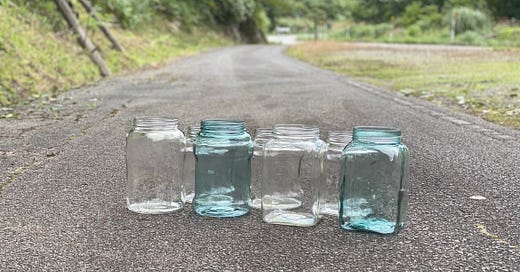Do you know all the different ways to pickle daikon? I don’t, but I’m learning.
One of my neighbors brought me a container with three or four different kinds of daikon, from smoked to sweet and sour. She shared her pickles and instantly took me back to when I had to throw away gallons of pickles a few summers ago. It was an important lesson, but not for the reason you might think.
Back then, my husband and I were still living in Tokyo. My mother-in-law, Okasan (which means mother in Japanese), had already passed away, and my father-in-law was living in a nursing home near our condo. We visited Hiroshima at least once a year to tend to the empty house.
Empty was the wrong word. Though we were all living in Tokyo, the house was still full of my in-laws—full of their life, their memories, their things. (And yes, it was and still is home to a number of spiders!)
On every trip home, I tried to tackle a different area of the house that needed attention. I’d tell myself these projects were important to do. The projects were good for the house and a good task for a devoted daughter-in-law. My husband knew that whatever I’d chosen to tackle was actually an excuse to keep me away from writing.
That summer, I decided to tackle the “yukashita” in the kitchen, or literally, the “under-floor” space. Many Japanese homes have a special storage area accessed by a trapdoor in the kitchen floor. The under-floor space is naturally cool and good for storing canned goods.
Okasan used the under-floor space to store all of her umeboshi (pickled plums) and pickled rakkyo, a Japanese scallion similar to a shallot. She also kept store-bought canned fruit, extra bottles of soy sauce, cooking oil, cooking sake, and a variety of liquor.
Over time, the space filled up. Over time, the cans, jars, and bottles got pushed back and out of reach. Over time, some of the boxes holding the cans and bottles got moldy. Over time, no one wanted to open the trap door to the under-floor space.
I’m super sensitive to mold, and I was afraid that if we waited any longer, the mold would become a serious health threat. So, that summer, we pulled out everything and lined it up outside behind the house so I could sort out what was still salvageable. Clearing everything out of the space only took about 30 minutes, but sorting it took days and left me with a heavy heart.
Rumor has it that umeboshi will last over 100 years. Sure enough, Okasan’s umeboshi still looked and tasted good. However, I had to dump every one of the gallon jars of pickled rakkyo. I tasted them, to be sure. Instead of the crunchy bites of pickled onion flavor, my mouth was filled with mushy onion yuck that I quickly spit out.
We’ve all let food go to waste. I’m sure I could look in my refrigerator or cupboards now and find something outdated and no longer tasting great. When I find something, I have a twinge of guilt and let it go, praying it will go back to the Earth and recycle through the food chain again as quickly as possible.
Throwing away gallons of homemade pickled rakkyo broke my heart. I thought about the time it took to grow, harvest, and peel each bite-sized rakkyo so there would be enough to fill a gallon jar. I tried to calculate the hundreds of rakkyo that went into each jar. I thought about how tasty they would have been served with homemade curry or eaten standing in front of the refrigerator at 2:00 a.m. when I couldn’t sleep.
I was angry. Why didn’t Okasan share the rakkyo with us? What was she saving them for? Why did she let them go to waste? Why did she keep making them each year when there were still so many leftover? Why didn’t I check the under-floor space sooner?
The rakkyo and other canned goods didn’t go completely to waste. I took bucketful after bucketful up the path behind the house to the base of the cherry tree, where we usually dump vegetable scraps from the kitchen. I don’t know how the tree felt, but I did observe many insects and small critters that were happy with the offering.
As I washed out all the jars, I thought about my own rakkyo. I don’t mean real pickled rakkyo. I mean all the services I’ve created over the years and then never promoted. I thought about all the words I’ve written and never shared. I thought about my clients who have done the same.
It’s time to share.
What’s your “rakkyo”?
Maybe it’s an idea you’ve been saving for “someday,” or a project you’ve hesitated to put out into the world. Whatever it is, let this be a gentle nudge: don’t let it go to waste. Share it. You never know who might be waiting to receive it.
Now, the house in Hiroshima is my home. I’m slowly filling the yukashita with my own pickles, and next summer I hope to make rakkyo. But for today, posting to Substack is my way of sharing my “rakkyo.” I’ve been hesitant to start, uncertain about what to say or how it might be received. I’m grateful to my neighbor for sharing her pickles—her small act of generosity prompted me to start sharing too.
So here it is, my first post. Thank you for reading and being part of this journey.




The post was so thought provoking, especially when I think of the things I have not shared or put into the world. I love the image of the trapdoor in the kitchen-the things we've done and not shared with others are literally under our feet. I loved your reverence for Okasan's effort in making the Rikkyo. That was so touching. This was a perfect new year post!!